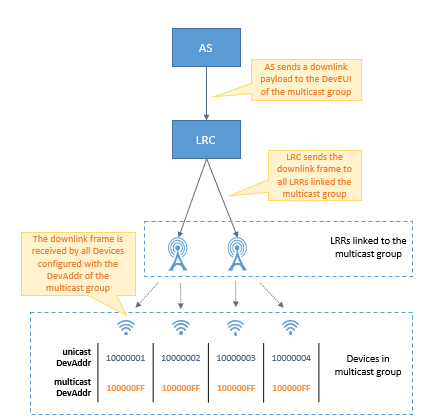About Multicast groups
A multicast group is a group of devices that receive the same downlink frame at the same time, as shown in the figure below.

A multicast group aims at managing devices in group like upgrading firmware and automatizing reconfiguration over the air. The group of devices can receive a message from the AS at the same moment, which means a guaranteed synchronized action on deployed devices (switching ON/OFF streetlamps..). LoRaWAN® devices consume little power and typically run on batteries. They usually wake up only when they have data to transmit and then immediately go back into sleep mode. Therefore to transmit a frame to an entire group of devices, the system must first ensure that the receivers of all the devices in the group are in active mode at the same time and for the same duration.
Unicast OTAA or ABP devices supporting multicast can receive simultaneously the same downlink payload in a LoRaWAN® network if they:
-
Share the same LoRaWAN® version, identifiers, keys, and class as the multicast group they will work with, whether they have been already provisioned or not with their own LoRaWAN® version, identifiers and keys as unicast devices.
-
Are in the coverage of one or more base stations having their tag added to this multicast group.
The multicast downlink is an unconfirmed data down message without MAC commands. For more information, see LoRaWAN® tunnel interface.
Since the devices inside the multicast group share the same security environment, that is DevAddr and session keys (NwkSKey and AppSKey), the multicast group can be considered as a single "virtual" ABP device. Nonetheless, the devices inside the multicast group keep their unicast DevAddr and session keys.
Only class B or class C end-devices can support multicast. Native Class-A devices can still use multicast if they are configured by application-layer to switch to class B or C during the multicast session scheduling period. For more details, see the LoRaWAN® Remote Multicast Setup Specification v1.0.0.
Even though a device is part of a multicast group, it keeps its DevEUI and DevAddr to still receive and send messages as a unicast device. For example, a device can use OTAA for unicast purpose and ABP for multicast purpose. To learn more, click Activation modes.
Notes
-
A single device can be part of up-to four multicast groups.
-
Up-to 1000 base stations can be associated with a single multicast group.